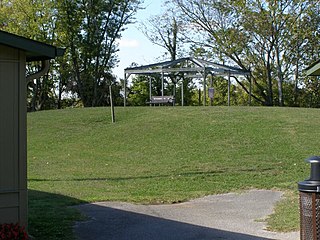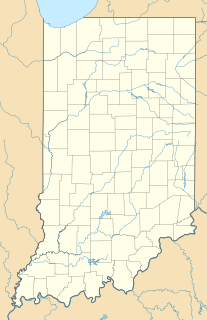
Angel Mounds State Historic Site, an expression of the Mississippian culture, is an archaeological site managed by the Indiana State Museum and Historic Sites that includes more than 600 acres of land about 8 miles (13 km) southeast of present-day Evansville, in Vanderburgh and Warrick counties in Indiana. The large residential and agricultural community was constructed and inhabited from AD 1100 to AD 1450, and served as the political, cultural, and economic center of the Angel chiefdom. It extended within 120 miles (190 km) of the Ohio River valley to the Green River in present-day Kentucky. The town had as many as 1,000 inhabitants at its peak, and included a complex of thirteen earthen mounds, hundreds of home sites, a palisade (stockade), and other structures.

The Mississippian culture was a Native American civilization that flourished in what is now the Midwestern, Eastern, and Southeastern United States from approximately 800 CE to 1600 CE, varying regionally. It was known for building large, earthen platform mounds, and often other shaped mounds as well. It was composed of a series of urban settlements and satellite villages (suburbs) linked together by loose trading networks. The largest city was Cahokia, believed to be a major religious center located in what is present-day southern Illinois.

Wickliffe Mounds is a prehistoric, Mississippian culture archaeological site located in Ballard County, Kentucky, just outside the town of Wickliffe, about 3 miles (4.8 km) from the confluence of the Ohio and Mississippi rivers. Archaeological investigations have linked the site with others along the Ohio River in Illinois and Kentucky as part of the Angel Phase of Mississippian culture. Wickliffe Mounds is controlled by the State Parks Service, which operates a museum at the site for interpretation of the ancient community. Listed on the National Register of Historic Places, it is also a Kentucky Archeological Landmark and State Historic Site.

Caborn-Welborn was a prehistoric North American culture defined by archaeologists as a Late Mississippian cultural manifestation that grew out of – or built upon the demise of – the Angel chiefdom located in the territory of southern present-day Indiana. Caborn-Welborn developed around 1400 and seems to have disappeared around 1700. The Caborn-Welborn culture was the last Native American occupation of southern Indiana before European contact. It remains unclear which historic-era native group, if any, are their descendants.

Slack Farm is an archaeological site of the Caborn-Welborn variant of the Mississippian culture. Slack Farm is located near Uniontown, Kentucky close to the confluence of the Ohio River and the Wabash Rivers. The site included a Native American mound and an extensive village occupation dating between 1400–1650 CE. Although Slack Farm was long known to be one of the major villages of the Caborn-Welborn people, it became famous when it was very seriously damaged by looters in 1987.

The Kincaid Mounds Historic Site c. 1050–1400 CE, is a Mississippian culture archaeological site located at the southern tip of present-day U.S. state of Illinois. Kincaid Mounds has been notable for both its significant role in native North American prehistory and for the central role the site has played in the development of modern archaeological techniques. The site had at least 11 substructure platform mounds. Artifacts from the settlement link its major habitation and the construction of the mounds to the Mississippian period, but it was also occupied earlier during the Late Woodland period. The site was declared a National Historic Landmark in 1964 for its significance as a major Native American mound center and prehistoric trading post along the Ohio River.

The Plaquemine culture was an archaeological culture centered on the Lower Mississippi River valley. It had a deep history in the area stretching back through the earlier Coles Creek and Troyville cultures to the Marksville culture. The Natchez and related Taensa peoples were their historic period descendants. The type site for the culture is the Medora Site in Louisiana; while other examples include the Anna, Emerald, Holly Bluff, and Winterville sites in Mississippi.

Towosahgy State Historic Site (23MI2), also known as Beckwith's Fort Archeological Site, is a large Mississippian archaeological site with a Woodland period Baytown culture component located in Mississippi County, Missouri. It is believed to have been inhabited from c. 400-1350. The site is maintained by the Missouri Department of Natural Resources as a state historic site. The name Towosahgy is an Osage word which means "old town." It is not known if members of the historic Osage, who dominated a large area of present-day Missouri at the beginning of encounter with European colonizers, occupied the site. The site was acquired by the Missouri state park system in 1967 and added to the National Register of Historic Places in 1969 as NRIS number 69000113,

Tolu is an unincorporated community and census-designated place (CDP) in Crittenden County, Kentucky, United States. As of the 2010 census it had a population of 88. It is located along Kentucky Route 135 near the Ohio River. It is 14 miles (23 km) northwest of Marion, the county seat.

Hovey Lake-Klein Archeological Site is an archaeological site of the Caborn-Welborn variant of the Mississippian culture. Hovey Lake-Klein Archeological Site is located on the west bank of Hovey Lake, a backwater lake near the Ohio River close to its confluence with the Wabash River. The site was an extensive village occupation dating between 1400-1650 CE.

The Ashworth Archaeological Site is a significant archaeological site in the extreme southwestern corner of the U.S. state of Indiana. Located near the confluence of the Ohio and Wabash Rivers, it lies near several similar archaeological sites. It was first examined by archaeologists in the middle of the twentieth century and found to be the site of a relatively recent Native American village, and it has been designated a historic site because of its archaeological value.

The Nodena Phase is an archaeological phase in eastern Arkansas and southeastern Missouri of the Late Mississippian culture which dates from about 1400–1650 CE. The Nodena Phase is known from a collection of villages along the Mississippi River between the Missouri Bootheel and Wapanocca Lake. They practiced extensive maize agriculture and artificial cranial deformation and were members of a continent wide trade and religious network known as the Southeastern Ceremonial Complex, which brought chert, whelk shells, and other exotic goods to the area.

The Tolu Site is a prehistoric archeological site of the Mississippian culture near the unincorporated community of Tolu, Crittenden County, Kentucky, United States. It was built and occupied between 1200-1450 CE. No carbon dating has been performed at the site, but analysis of pottery styles suggest its major habitation period was 1200 to 1300 CE. The site originally had three mounds, a burial mound, a substructure platform mound and one other of undetermined function. It was excavated in 1930 by W.S. Webb and William D. Funkhouser.

Mississippian culture pottery is the ceramic tradition of the Mississippian culture found as artifacts in archaeological sites in the American Midwest and Southeast. It is often characterized by the adoption and use of riverine shell-tempering agents in the clay paste. Shell tempering is one of the hallmarks of Mississippian cultural practices. Analysis of local differences in materials, techniques, forms, and designs is a primary means for archaeologists to learn about the lifeways, religious practices, trade, and interaction among Mississippian peoples. The value of this pottery on the illegal antiquities market has led to extensive looting of sites.

The Rowlandton Mound Site (15MCN3) is a Mississippian culture archaeological site located in Paducah in McCracken County, Kentucky, on the edge of an old oxbow lake a little south of the Ohio River.

The Brentwood Library Site (40WM210), also known as the Jarman Farm Site, is a Mississippian culture archaeological site located in the city of Brentwood, in Williamson County, Tennessee. It was occupied during Regional Period IV of the local Mississippian chronology, and artifacts from the site have been radiocarbon dated to between 1298 to 1465 CE.

The Juntunen Site, also known as 20MK1, is a stratified Prehistoric Late Woodland fishing village located on the western tip of Bois Blanc Island. It was listed on the National Register of Historic Places in 1978.

The Yankeetown Site (12W1) is a substantial archaeological site along the Ohio River in the southwestern part of the U.S. state of Indiana. Inhabited during the prehistoric Woodland period, the site has yielded important information about Woodland-era peoples in the region, but it has been damaged by substantial erosion. Despite the damage, it has been a historic site for more than thirty years.

The Griesmer site (La-3) is located on the Kankakee River in Lake County, Indiana, about a mile southeast of Schneider, in Northwestern Indiana. It is classified as a Prehistoric, multi-component site with Middle Woodland, Late Woodland and Upper Mississippian occupations. The deposits were not stratified, but observation of the types of artifacts present, together with radiocarbon dates, helped to define the sequence of occupations at the site.

The Knoll Spring site (11Ck-19), aka Au Sagaunashke Village, is located in the Sag Valley, Palos Hills, in Cook County, Illinois, near the city of Chicago. It is classified as a late Prehistoric site with Upper Mississippian Huber affiliation.



















